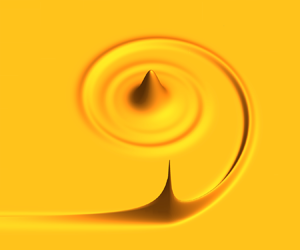Article contents
The starting vortices generated by bodies with sharp and straight edges in a viscous fluid
Published online by Cambridge University Press: 28 August 2024
Abstract

A two-dimensional body that moves suddenly in a viscous fluid can instantly generate vortices at its sharp edges. Recent work using inviscid flow theory, based on the Birkhoff–Rott equation and the Kutta condition, predicts that the ‘starting vortices’ generated by the sharp and straight edges of a body – i.e. the vortices formed immediately after motion begins – can be one of three distinct self-similar types. We explore the existence of these starting vortices for a flat plate and two symmetric Joukowski aerofoils immersed in a viscous fluid, using high-fidelity direct numerical simulations (DNS) of the Navier–Stokes equations. A lattice Green's function method is employed and simulations are performed for chord Reynolds numbers ranging from 5040 to 45 255. Vortices generated at the leading and trailing edges of the flat plate show agreement with the derived inviscid theory, for which a detailed assessment is reported. Agreement is also observed for the two symmetric Joukowski aerofoils, demonstrating the utility of the inviscid theory for arbitrary bodies. While this inviscid theory predicts an abrupt transition between the starting-vortex types, DNS shows a smooth transition. This behaviour occurs for all Reynolds numbers and is related to finite-time effects – there is a maximal time for which the (self-similar) starting vortices exist. We confirm the inviscid prediction that the leading-edge starting vortex of a flat plate can be suppressed dynamically. This has implications for the performance of low-speed aircraft such as model aeroplanes, micro air vehicles and unmanned air vehicles.
JFM classification
Information
- Type
- JFM Papers
- Information
- Copyright
- © The Author(s), 2024. Published by Cambridge University Press
References
- 3
- Cited by


